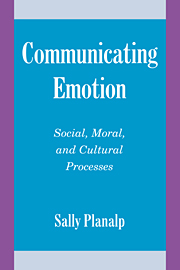Book contents
- Frontmatter
- Dedication
- Contents
- Acknowledgments
- Introduction
- 1 How Important Is Emotion in Everyday Interaction?
- 2 How and Why Is Emotion Communicated?
- 3 Is Emotional Communication Spontaneous or Strategic?
- 4 How Is Emotional Meaning Constructed Through Communication?
- 5 How Is Emotional Meaning Both Personal and Social?
- 6 How Do Emotion Messages Communicate Moral Meaning?
- 7 How Is Emotional Communication Grounded in Common Human Experience and Diverse Cultures?
- Epilogue: What is the Future of Emotional Meaning?
- References
- Author Index
- Subject Index
5 - How Is Emotional Meaning Both Personal and Social?
Published online by Cambridge University Press: 05 February 2015
- Frontmatter
- Dedication
- Contents
- Acknowledgments
- Introduction
- 1 How Important Is Emotion in Everyday Interaction?
- 2 How and Why Is Emotion Communicated?
- 3 Is Emotional Communication Spontaneous or Strategic?
- 4 How Is Emotional Meaning Constructed Through Communication?
- 5 How Is Emotional Meaning Both Personal and Social?
- 6 How Do Emotion Messages Communicate Moral Meaning?
- 7 How Is Emotional Communication Grounded in Common Human Experience and Diverse Cultures?
- Epilogue: What is the Future of Emotional Meaning?
- References
- Author Index
- Subject Index
Summary
No matter how deeply personal an emotion seems, we embark on a timeless drama not of our own making.
Cochran and Claspell (1987: 157)The mere fact that we communicate emotion implies that emotion itself is both personal and social. If our feelings were entirely personal, with no shared meaning and no implications for others, there would be no need to communicate them. Emotions might help us as individuals to orient to important concerns and guide our actions, but they would not interest anybody else. At the opposite extreme, there would also be no need to communicate emotions if they were entirely social. If members of a community felt in unison, emotions would serve to orient the group to common concerns and to coordinate behavior, but there would be no individual variation from one member to another. But emotions are neither purely personal nor purely social; they are both. Through communication, our personal emotional experiences are made available to others in society, and at the same time, social expectations about emotion are made known to us as individuals. Communication is a way of bridging the gap between the personal and the social sides of emotion.
The process of communicating emotions is deeply personal in several senses of the word. It is personal in the sense that the emotions define us as individuals with configurations of feelings that are unique – like fingerprints. Emotional communication is also commonly expressed physically and thus is closely linked to the body, the ultimate locus of the personal self. Emotion is also personal in the sense of being private. Often our feelings are difficult, if not impossible, to communicate fully and may be too sensitive to expose to anyone else. And emotional communication is personal in the sense that revealing our deepest feelings to others is considered an intimate act.
- Type
- Chapter
- Information
- Communicating EmotionSocial, Moral, and Cultural Processes, pp. 134 - 159Publisher: Cambridge University PressPrint publication year: 1999

